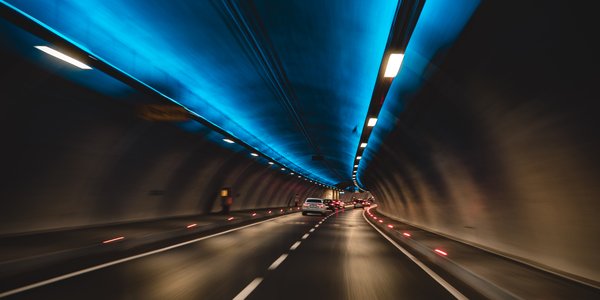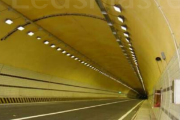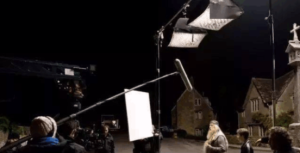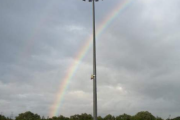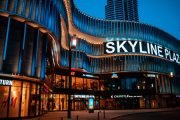The Characteristics of Tunnel Visual Phenomena
During the day, the driver enters the tunnel until exits the tunnel, and will encounter many visual problems.
Visual problems before entering the tunnel: In a long tunnel, the driver sees a dark hole. This is the “black hole” phenomenon. In a short tunnel, a “black frame” appears in front of the driver.
External high brightness, low entrance brightness, stray light in the air, affecting the brightness of the windshield-a visual phenomenon that can occur when entering the tunnel, from the bright outside into a darker tunnel, because the driver’s vision needs a certain adaptation time (Dark adaptation of vision), so he can’t see the situation inside the tunnel quickly.
Visual Problems Inside the Tunnel
Inside the tunnel, the exhaust gas from the car dispatched by the car gathers in the tunnel to form smoke. The light of the car headlamp is absorbed and scattered by the smoke to form a light curtain, which reduces the distance between the front obstacle and the background (road surface, wall) Brightness contrast, thereby reducing the visibility of obstacles. The vision problem at the exit of the tunnel is in a very dark environment. Suddenly a bright source appears ahead, which will produce strong glare, so that the driver cannot see the road conditions clearly, and it is very prone to car accidents. In order for the driver to clearly see the small car in the shadow of the big car in front under the bright exit background, and to leave the exit to have a good backward vision, the exit needs to be illuminated.
The vision problem at the exit of the tunnel is in a very dark environment. Suddenly a bright source appears ahead, which will produce strong glare, so that the driver cannot see the road conditions clearly, and it is very prone to car accidents. In order for the driver to clearly see the small car in the shadow of the big car in front under the bright exit background, and to leave the exit to have a good backward vision, the exit needs to be illuminated.
To solve the above problems, tunnel lighting is divided into entrance lighting, interior lighting and exit lighting. Generally, the lighting level inside the tunnel is relatively low, and it is impossible to compare with the outside. Taking into account the adaptation of the human eye, the entrance lighting is gradually reduced, and national lighting with different illuminance levels is set.
Illumination characteristics of tunnels on different road sections
Approach segment
The approach section refers to a section of road outside the tunnel entrance, where the driver must be able to see the objects in the tunnel clearly. This is also the stage of the driver’s visual adjustment, which determines the illumination requirements of the tunnel entrance and tunnel entrance section. In the daytime, due to the strong contrast between the high brightness of the environment outside the entrance and the low brightness of the tunnel, and also due to the driver’s temporary visual impact on the bright environment, a tunnel entrance with insufficient lighting will cause people to have a “black hole effect” and any details inside the tunnel cannot be seen.
Entry section
The entrance section is the first section of the four sections of the tunnel. Drivers driving in the approaching section must be able to see the road conditions at the entrance before entering the tunnel to eliminate the “black hole” phenomenon. The length of the entrance section depends on the maximum speed of the tunnel design, at least equal to the braking distance (SSD) at the maximum speed. This is because the road at the far end of this section should be used as a background for drivers who are about to enter the tunnel beyond the safe braking distance to see the obstacles clearly.
Transition Section
After a relatively high threshold section of the lighting level, the lighting level in the tunnel can be gradually reduced to a very low level, and this gradually decreasing area is the transition section. The length of the transition section depends on the design maximum speed and the difference between the lighting level at the tail of the entrance section and the interior section. The transition section may be divided into 1 to 3 sections according to different lighting levels.
Internal segment
As its name suggests, the inner section is the area in the tunnel away from the influence of natural light from outside. The driver’s vision is only affected by the lighting in the tunnel. The characteristic of the internal section is that the entire section has a uniform lighting level, because there is no need to change at all, the section only needs to provide a suitable brightness level, and the specific value is determined by the traffic flow and the design speed.
Exit section
The exit section is the last section of a one-way tunnel. The vision of the driver approaching the exit is affected by the brightness outside the tunnel. In order to prevent the impact of reduced vision, that is, glare, due to high brightness stimulation when exiting the tunnel, this may cause the driver to be unable to see in time To clear the small cars driving in the shadow of the big cars ahead, the exit section must be illuminated.
Middle Section Brightness
1)Middle section brightness
a. The brightness of the middle section is as follows
|
Design speed |
Lin(cd/m2) |
|
| Two-lane one-way traffic> 2400 vehicles/H |
Two-lane one-way traffic <700 vehicles/H |
|
|
Two-lane two-way traffic volume>1300 vehicles/H |
Two-lane two-way traffic volume<360 vehicles/H |
|
|
100 |
9 |
4 |
|
80 |
4.5 |
2 |
|
60 |
2.5 |
1.5 |
|
40 |
1.5 |
1.5 |
b. In the tunnel where people and vehicles pass through, the brightness value of the middle section is not less than 2.5 cd/m2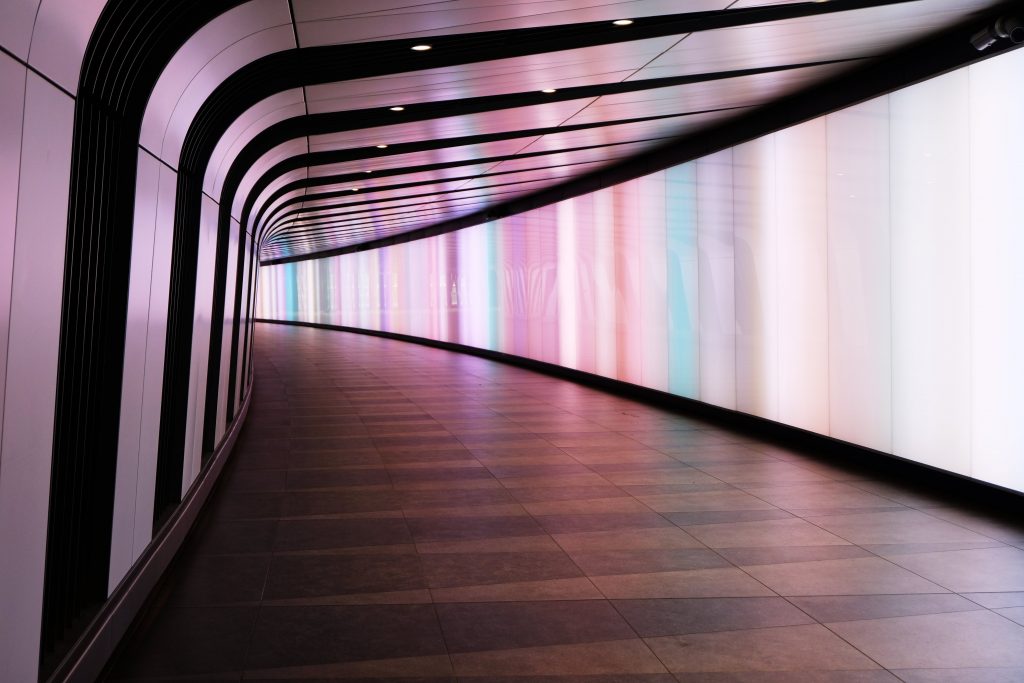
c. Within the 2m high range of the walls on both sides of the tunnel, wall materials with a reflectivity of not less than 0.7 should be laid. The average brightness in the 2m high range of the walls on the left and right sides of the road surface should not be lower than the average brightness of the road surface. The conversion relationship between average brightness and average lighting can generally be based on asphalt pavement (15-22) lx/cd. M-2, cement pavement (10-13) lx/cd. M-2 takes the value.
2)The lighting arrangement meets the following requirements
a.The lighting arrangement should satisfy the flicker frequency lower than 2.5Hz or higher than 15Hz,
b.The layout of the middle section of the lamps can be arranged in the center line, staggered on both sides or symmetrically arranged on both sides.
c. The total uniformity of the road surface brightness is not less than the following requirements:
|
Design traffic N (Vehicles/H) |
U1 |
|
|
Two-lane one-way traffic |
Two-lane two-way traffic |
|
|
>2400 |
>1300 |
0.6-0.7 |
|
<700 |
<360 |
0.5 |
d. Longitudinal uniformity of road surface centerline brightness is not less than 0.5,
e. Fluorescent lighting should be used for emergency parking lanes, and the brightness of the lighting
should be greater than 7cd/m2, and the brightness of the connecting channel should be greater than 2 cd/m2.
The lighting fixtures in the middle section are arranged from the entrance to the exit of the tunnel, as the basic lighting during the day and lighting at night. The areas that need to be illuminated should be lighted on this basis.
Entrance section lighting
1)The entrance lighting can be calculated according to the following formula
Lth=K x L20
Lth is the brightness of the entrance section (cd/m2), K is the brightness reduction coefficient of the entrance section, and L20 is the brightness outside the tunnel.
★Entrance section brightness reduction coefficient:
|
Design traffic volume N (vehicles/H) |
K |
||||
| Design driving speed (km/H) | |||||
|
Two-lane one-way traffic |
Two-lane two-way traffic |
100 |
80 |
60 |
40 |
|
>2400 |
>1300 |
0.045 |
0.035 |
0.022 |
0.012 |
|
<700 |
<360 |
0.035 |
0.025 |
0.015 |
0.01 |
2)Brightness outside the cave
a. The brightness outside the tunnel is in the design stage, if there is no actual measurement data, you can select the following table:
|
Sky area percentage |
Orientation of cave opening or environment outside cave | 40km/H | 60km/H | 80km/H | 100km/H |
|
35-50% |
South entrance |
/ |
/ | 4000 | 4500 |
|
North entrance |
/ |
/ | 5500 | 6000 | |
|
25% |
South entrance |
3000 |
3500 | 4000 | 4500 |
|
North entrance |
3500 |
4000 | 5000 | 5500 | |
|
10% |
Dark environment |
2000 |
2500 | 3000 | 3500 |
|
Bright environment |
3000 |
3500 | 4000 | 4500 | |
|
0% |
Dark environment |
1000 |
1500 | 2000 | 2500 |
|
Bright environment |
2500 |
3000 | 3500 | 4000 |
b. After the completion of the civil construction of the cave entrance, the brightness outside the cave should be measured. When the difference between the measured and actual value exceeds 25%, the lighting system should be adjusted.
c. When the brightness outside the cave is measured, the measured position should be the starting point of the approaching section, and the length of the approaching section should be taken from an illuminated parking sight outside the cave.
3)Lighting Arrangement at Entrance
a. The lighting of the entrance section consists of two parts: basic lighting and enhanced lighting. The former is considered based on the lighting of the middle section, and the latter can be enhanced with lamps with higher power.
b. The reinforced lighting fixtures in the entrance section can be arranged from 10m vehicle distance within the opening.
4)Lighting of the entrance section of a continuous tunnel
When the travel time between the two tunnels is less than 30S according to the calculated speed, and the travel time in the previous tunnel passed is greater than 30S, the brightness reduction of the subsequent tunnel entrance section is selected according to the following table:
|
Travel time between two tunnels |
<2 |
<5 |
<10 |
<15 |
<30 |
| Subsequent tunnel entrance section brightness reduction rate(%) |
50 |
30 |
25 |
20 |
15 |
Transition lighting
1)Transition brightness
The brightness of the transition section is composed of three lighting sections, TR1, TR2, and TR3, and the corresponding brightness is taken in the following table:
| Lighting section | TR1 | TR2 | TR3 |
| luminance | LTR1=0.3Lflx | LTR2=0.1Lflx |
LTR3=0.035Lflx |

